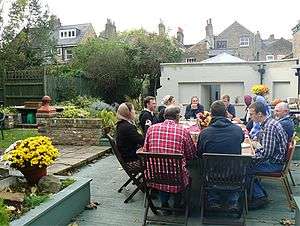Intentional community
An intentional community is a planned residential community designed from the start to have a high degree of social cohesion and teamwork. The members of an intentional community typically hold a common social, political, religious, or spiritual vision and often follow an alternative lifestyle. They typically share responsibilities and resources. Intentional communities include collective households, cohousing communities, coliving, ecovillages, monasteries, communes, survivalist retreats, kibbutzim, ashrams, and housing cooperatives. New members of an intentional community are generally selected by the community's existing membership, rather than by real-estate agents or land owners (if the land is not owned collectively by the community).

Characteristics
Purpose
The purposes of intentional communities vary in different communities. They may include sharing resources, creating family-oriented neighborhoods, and living ecologically sustainable lifestyles, such as in ecovillages.
Types of communities
Some communities are secular while others have a spiritual basis.[1] One common practice, particularly in spiritual communities, is communal meals.[2] Typically, there is a focus on egalitarian values.[3] Other themes are voluntary simplicity, interpersonal growth, and self-sufficiency.
Some communities provide services to disadvantaged populations. These include, but are not limited to, war refugees, homeless people, or people with developmental disabilities. Some communities operate learning and/or health centers. Other communities, such as Castanea of Nashville, Tennessee, offer a safe neighborhood for those exiting rehab programs to live in. Some intentional communities are also micronations, such as Freetown Christiania.[4]
Types of memberships
Many communities have different types or levels of membership. Typically, intentional communities have a selection process which starts with someone interested in the community coming for a visit. Often prospective community members are interviewed by a selection committee of the community or in some cases by everyone in the community. Many communities have a "provisional membership" period. After a visitor has been accepted, a new member is "provisional" until they have stayed for some period (often six months or a year) and then the community re-evaluates their membership. Generally, after the provisional member has been accepted, they become a full member. In many communities, the voting privileges or community benefits for provisional members are less than those for full members.
Christian intentional communities are usually composed of those wanting to emulate the practices of the earliest believers. Using the biblical book of Acts (and, often, the Sermon on the Mount) as a model, members of these communities strive for a practical working out of their individual faith in a corporate context.[5] These Christian intentional communities try to live out the teachings of the New Testament and practice lives of compassion and hospitality.[6] Communities such as the Simple Way, the Bruderhof[7] and Rutba House would fall into this category. These communities, despite strict membership criteria, are open to visitors and not reclusive in the way that certain intentional communities are.[8]
A survey in the 1995 edition of the "Communities Directory", published by Fellowship for Intentional Community (FIC), reported that 54 percent of the communities choosing to list themselves were rural, 28 percent were urban, 10 percent had both rural and urban sites, and 8 percent did not specify.[9]
Type of governance
The most common form of governance in intentional communities is democratic (64 percent), with decisions made by some form of consensus decision-making or voting. A hierarchical or authoritarian structure governs 9 percent of communities, 11 percent are a combination of democratic and hierarchical structure, and 16 percent do not specify.[9] Many communities which were initially led by an individual or small group have changed in recent years to a more democratic form of governance.
See also
- Community garden
- Cooperation
- List of intentional communities
- Utopian socialism
References
- "Spiritual Communities: There's More to Them Than Meets the Third Eye".
- Mangan, Lucy (2019-07-25). "Inside the Bruderhof review – is this a religious stirring I feel?". The Guardian. ISSN 0261-3077. Retrieved 2019-07-31.
- "Feminism, Empowerment, and Justice | Dancing Rabbit Ecovillage". Retrieved 2019-07-31.
- "Experience colourful Christiania". Visitcopenhagen (in Lingala). Retrieved 2017-10-27.
- "Bruderhof - Fellowship for Intentional Community". Fellowship for Intentional Community. Retrieved 2017-11-11.
- Fellowship for Intentional Community. 1995. Communities Directory. 2nd Edition. Rutledge, Missouri, USA. ISBN 0-9602714-4-9.
- "5 Beliefs That Set the Bruderhof Apart From Other Christians". Newsmax. Retrieved 2017-05-15.
- "Learning from the Bruderhof: An Intentional Christian Community". ChristLife. Retrieved 2017-10-27.
- Fellowship for Intentional Community. 2005. Communities Directory. 4th Edition. Rutledge, Missouri, USA. ISBN 0-9718264-2-0.
Further reading
- Christian, Diana Leafe (2003). Creating a life together : practical tools to grow ecovillages and intentional communities. Gabriola Island, BC: New Society Publishers. ISBN 9781550923162. OCLC 232159819.
- Curl, John (2007) Memories of Drop City, the First Hippie Commune of the 1960s and the Summer of Love: a memoir. iUniverse. ISBN 0-595-42343-4.
- Kanter, Rosabeth Moss (1972) Commitment and Community: communes and utopias in sociological perspective. Cambridge, Massachusetts: Harvard University Press. ISBN 0-674-14575-5
- McLaughlin, C. and Davidson, G. (1990) Builders of the Dawn: community lifestyles in a changing world. Book Publishing Company. ISBN 0-913990-68-X
- Lupton, Robert C. (1997) Return Flight: Community Development Through Reneighboring our Cities, Atlanta, Georgia:FCS Urban Ministries.
- Moore, Charles E. Called to Community: The Life Jesus Wants for His People. Plough Publishing House, 2016.
- “Intentional Community.” Plough, Plough Publishing, www.plough.com/en/topics/community/intentional-community.
- Mariani, Mike: The New Generation of Self-Created Utopias, The New York Times, January 16, 2020
External links
- Intentional community at Curlie
- Intentional Communities website
- Intentional Communities Wiki
- Intentional Community For Media and Spirituality
- Diggers & Dreamers UK directory & Journal
- eurotopia European Directory of Communities and Ecovillages
- The Twitter Age Embraces Communal Living – slideshow by The New York Times
- International Communes Desk